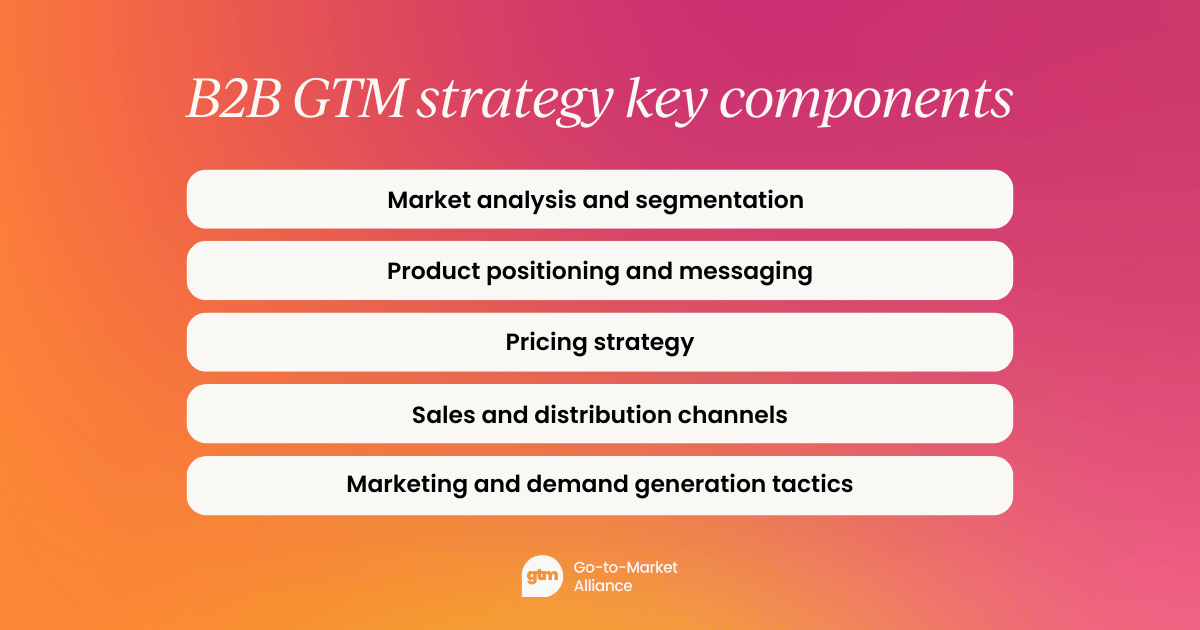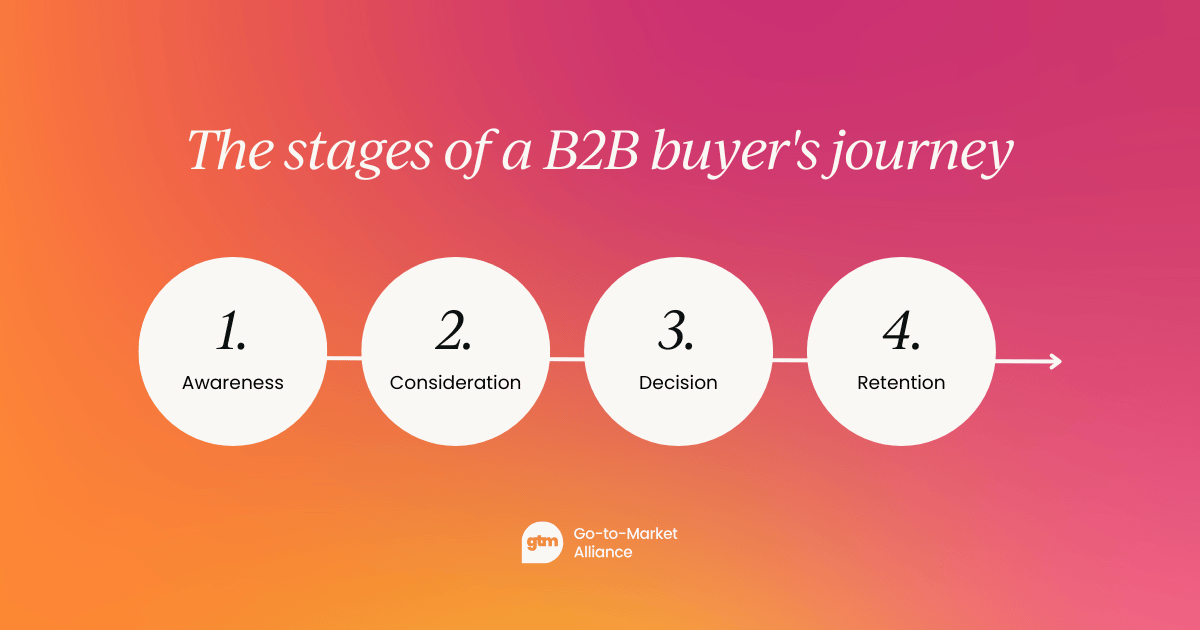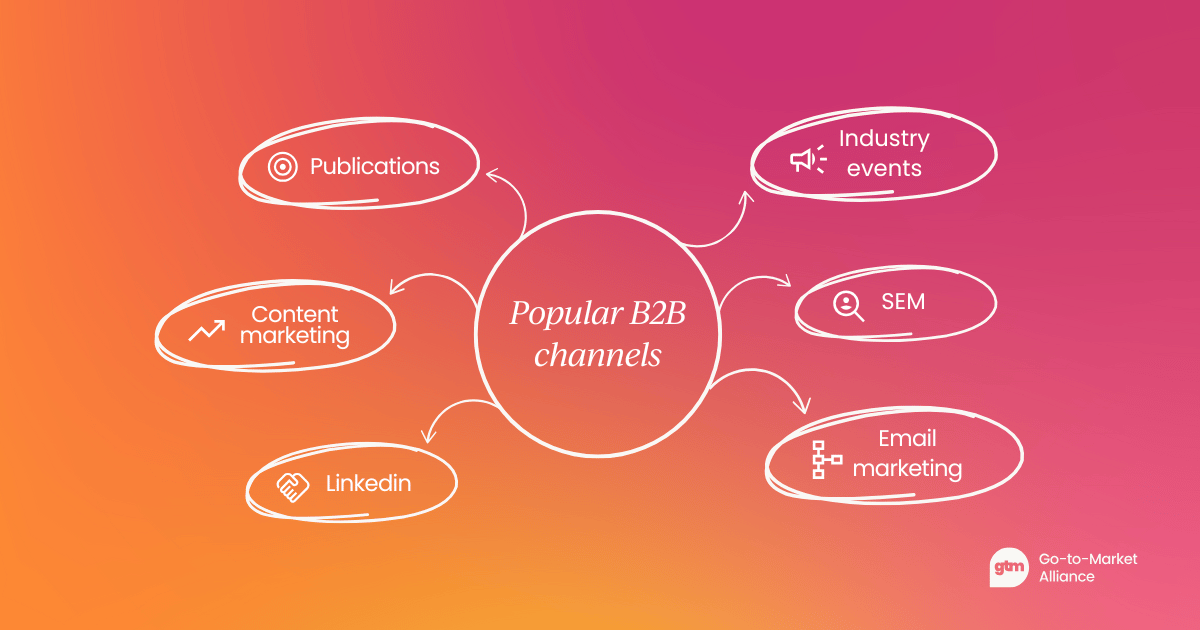Picture this: You have an amazing product that could completely change how businesses operate. You're pumped, your team's excited, and you're ready to make a big splash in the market. But here's the million-dollar question – how exactly will you do that?
This is where the B2B go-to-market (GTM) strategy comes into play. But what exactly is this, and why does it matter so much?
Simply put, it's your company's game plan for bringing your products or services to your target market. It's the roadmap that guides everything from how you position your offering to how you'll reach and convert your ideal customers.
As the B2B landscape grows ever-competitive, a well-crafted GTM strategy can determine whether you'll succeed or not. Don’t believe us? Recent studies have shown that companies with a well-structured GTM strategy are 33% more likely to hit their revenue targets than those without one. That's a pretty compelling reason to read ahead, don't you think?
So, without further ado, let's get started!
What is a B2B go-to-market strategy?
Have you ever wondered how some companies seem to flawlessly introduce new products while others falter?
Well, let’s clear it up for you and dive a little deeper into what we mean by a B2B GTM strategy. It's not just a fancy term for a marketing plan – it's much more comprehensive than that.
A B2B go-to-market strategy is a detailed game plan for how a company will find its target market, communicate its value proposition, and ultimately deliver its product or service to customers.
Think of a B2B go-to-market strategy like the plan for a complex expedition. For the expedition to be successful you’ll need to carefully prepare, understand the terrain, choose the best path, and be able to adapt to changing weather conditions.
The key components of a B2B GTM strategy typically include:
- Market analysis and segmentation
- Product positioning and messaging
- Pricing strategy
- Sales and distribution channels
- Marketing and demand generation tactics
What sets B2B GTM strategies apart from their B2C counterparts is the complexity of the buying process. In B2B, you're often dealing with longer sales cycles, multiple decision-makers, and higher-stakes purchases.
Therefore, your GTM strategy needs to account for these unique challenges and you should tailor your approach accordingly.

Why your B2B company needs a strong go-to-market strategy
An effective strategy for B2B companies is all about getting everyone in your company on the same page – from marketing and sales to product development and customer success – around a common goal: market domination.
Now, you might be thinking, "Do I really need to go through all this trouble? Can't I just wing it?" Well, you could, but you'd be leaving a whole lot of money on the table. Here’s exactly why:
Impact on revenue and growth
A well-executed GTM strategy can significantly boost your bottom line. It helps you identify the most profitable market segments, make the best use of what you've got, and speed up how quickly you can make sales.
Companies with a clear GTM strategy have been shown to achieve 30% higher revenue growth and 30% higher profitability than their peers.
Could your business afford to miss out on this potential revenue growth by skipping a well-planned strategy? An ecommerce Go-to-Market strategy, or strategy for any very competitive industry, is essential.
Competitive advantages
In a crowded marketplace, a solid GTM strategy helps you stand out. It allows you to clearly articulate your unique value proposition and position your offering in a way that resonates with your target audience.
This differentiation can be the key to winning over customers who might otherwise go to your competitors.
Here’s a good example to prove this. When Apple stepped into the mobile phone arena in 2007, they were up against giants like Nokia and BlackBerry. To tackle this challenge, Apple crafted a go-to-market plan centered around standing out and breaking the mold.
They didn't just introduce a phone; they unveiled a device that rolled a phone, an MP3 player, and an internet tool into one. By highlighting the iPhone's revolutionary touch screen and app capabilities, they set it apart from the crowd of phones with buttons.
This calculated move helped Apple catch up fast, grabbing a big slice of the market and setting the stage to lead the smartphone world. It's a classic story of how a well-thought-out plan can change everything.
Risk mitigation
Launching a new product or entering a new market is always risky. A GTM strategy helps you mitigate these risks by ensuring you've done your homework.
It forces you to thoroughly analyze your market, understand your customers' needs, and validate your assumptions before making significant investments.
Wouldn't you prefer to enter a new market with the assurance that you've minimized potential pitfalls?
Resource optimization
Without a clear GTM strategy, it's easy to waste resources on ineffective tactics or pursue the wrong opportunities. A well-thought-out strategy helps you focus your efforts where they'll have the most impact, maximizing your return on investment.
In other words, a solid GTM strategy isn't just nice to have – it's a serious competitive advantage that can boost your growth and profits significantly. So, if you're not giving your GTM strategy the attention it deserves, you're essentially handing your competitors the head start.

Essential components of a successful B2B go-to-market plan
Now that we've covered the 'why', let's dive into the 'what'. A successful B2B GTM plan typically includes several key components:
1. Know your market inside and out
First things first: before you even think about charging into the market, you need to do your homework. We're not talking about a quick Google search here - we're talking about a deep, comprehensive analysis of your market landscape. Here's what you need to focus on:
🧠 Sizing up your competition
Who else is playing in your sandbox? What are their strengths and weaknesses? Don't just look at the obvious competitors – keep an eye out for potential disruptors who might be coming at the problem from a completely different angle.
📈 Identifying market trends
What's hot and what's not in your industry? Are there emerging technologies or shifting customer preferences that could impact your offering? Staying ahead of trends can help you position your product or service for long-term success.
🔍 Spotting gaps and opportunities
Where are there gaps in what customers want? Are there customer problems that no one else is addressing effectively? These gaps could be your ticket to carving out a unique and valuable niche.
2. Get cozy with your ideal customer
You can't be everything to everyone, so save yourself the trouble. Instead, focus on identifying your ideal customer profile (ICP) and getting to know everything about them. Here's what you need to dig into:
Firmographics
What kind of companies are you targeting? Consider factors like:
- Industry
- Company size (both employee count and revenue)
- Geographic location
- Technological maturity
Pain points
What keeps your potential customers up at night? What are the big problems they're facing that your solution can address? Understanding these frustrations is crucial for crafting a compelling value proposition.
Buying behaviors
How do your target customers typically make purchasing decisions? Who's involved in the process? What criteria do they use to evaluate solutions? Mapping out the buying process can help you customize how you sell effectively.
Detailed buyer personas
Go beyond just company profiles and create detailed personas for the key decision-makers and influencers within your target organizations. What are their goals, challenges, and preferences? What kind of content do they consume? Where do they hang out online?
Remember, the more intimately you understand your ideal customers, the better you can tailor your entire GTM approach to resonate with them.

3. Craft a knockout value proposition
Your value proposition is your secret weapon – it's the core message that explains why customers should choose you over the competition.
But here's the thing: a weak, generic value proposition will keep you stalled. You need something that truly stands out and speaks directly to your ideal customers' needs and desires.
Here's what your value proposition needs to nail:
Problem identification
Clearly articulate the specific problem or challenge that your product or service solves. Make sure it's a problem that your target audience actually cares about solving.
Unique solution
Explain how your offering solves the problem in a way that's different (and better) than existing solutions. What's your secret sauce?
Clear benefits
Don't just list features – translate them into concrete benefits that your customers will experience. How will their lives or businesses improve by choosing your solution?
Proof and credibility
Back up your claims with evidence. This could be in the form of case studies, testimonials, or hard data that demonstrates the effectiveness of your solution.
4. Map out the buyer's journey
Understanding how your customers move from ignorance to becoming your biggest fans is crucial for crafting an effective GTM strategy. By mapping out the buyer's journey, you can ensure you're delivering the right message, through the right channels, at exactly the right time.

Here's a breakdown of the typical B2B buyer's journey stages:
1. Awareness
At this stage, potential customers are just realizing they have a problem or opportunity. They're starting to do some initial research to better understand their situation.
👉 Your job: Provide educational content that helps them define their problem and understand potential solutions. Think blog posts, infographics, and high-level whitepapers.
2. Consideration
Now, your potential customers are actively evaluating different solutions to their problem. They're comparing options and trying to figure out which approach is best for their specific situation.
👉 Your job: Share in-depth content that shows why your product is the right choice, showcasing your expertise and the unique benefits of your approach. Case studies, product comparisons, and in-depth guides work well here.
3. Decision
At this point, your prospects have narrowed down their options and are ready to make a final decision. They're looking for that last bit of reassurance that they're making the right choice.
👉 Your job: Provide content that makes it easy for them to say "yes" to your solution. Think customer testimonials, free trials, detailed product demos, and ROI calculators.
4. Retention and advocacy
The buyer's journey doesn't end with the purchase. To get the most value from each customer and turn customers into advocates, you need to continue nurturing the relationship post-sale.
👉 Your job: Provide great help to your customers, provide ongoing education and resources, and actively seek and act on customer feedback.
By aligning your marketing efforts, sales process, and content strategy with these stages, you can make it easy and pleasant, guiding prospects smoothly through the buying process.
5. Choose your channels wisely
In the B2B world, not all marketing channels are created equal. Your GTM strategy needs to outline exactly which channels you'll use to reach your audience and how you'll leverage each one for maximum impact. Here's what you need to consider:
Find the best places to reach your audience
Where does your target audience hang out? Which channels are most effective for reaching decision-makers in your industry? Some popular B2B channels include:

Make plans tailored to each platform
Each channel requires a unique approach. For example:
- LinkedIn: You would focus on thought leadership content, employee advocacy, and targeted advertising.
- Email marketing: You would develop nurture campaigns that provide value at each stage of the buyer's journey.
- Content marketing: You’d create a comprehensive content calendar that aligns with your buyers' needs and search intent.
Make sure your message is the same everywhere
While each channel may require a unique approach, your overall message and branding should be consistent across all touchpoints. Create a cohesive multi-channel strategy that guides prospects through the buyer's journey.
Measure and optimize
Regularly assess the performance of each channel using relevant metrics, such as engagement rates or conversion rates. Be prepared to double down on what's working and cut or adjust underperforming channels.
Remember, it's better to excel in a few key channels than to spread yourself too thin trying to be everywhere at once.
6. Align your team for GTM success
Your GTM strategy isn't just a marketing thing or a sales thing – it's an everyone thing. To truly succeed, you need to get your entire organization on the same page.
Trust us: Businesses that align their GTM strategy across departments see a 36% improvement in customer retention and a 38% higher sales win rate.
Here's how to make that happen:
Cross-functional collaboration
Break down the silos between departments and foster a culture of collaboration. Some key areas to focus on:
- Sales and marketing alignment: Ensure both teams are using the same language, targeting the same ideal customers, and working towards shared goals.
- Product-market fit: Get your product team involved early to ensure your offering truly meets market needs.
- Customer success integration: Loop in your customer success team to ensure a smooth handoff from sales and to gather valuable feedback for continuous improvement.
Clear communication of your strategy
Make sure everyone in the organization understands the GTM strategy and their role in executing it. This might involve company-wide presentations, department-specific training sessions, or regular updates and progress reports.
Feedback loops
Establish mechanisms for gathering and acting on feedback from all parts of the organization. This could include anything from regular cross-functional meetings to a centralized platform for sharing insights.
By getting everyone on the same page and working towards a common goal, you'll be able to execute your GTM strategy with much greater efficiency and effectiveness.
7. Set clear KPIs and keep score
As the old saying goes, "What gets measured, gets managed." To ensure your GTM strategy is actually delivering results, you need to set clear, measurable key performance indicators (KPIs) and track them religiously. Here are some key metrics to consider:
- Customer Acquisition Cost
- Customer Lifetime Value
- Time to Close
- Conversion Rates
- Market Share
- Net Promoter Score
- Revenue Growth Rate
Don't just set it and forget it. Regularly review these metrics (at least monthly, if not more frequently) and be ready to make adjustments to your strategy based on what the data is telling you.

Common B2B go-to-market challenges and solutions
Even with a solid strategy, you're bound to face some challenges along the way. Here are some common hurdles in B2B GTM and how to overcome them:
Long sales cycles
B2B sales cycles can stretch for months or even years. To shorten them:
💡 Focus on educating prospects early in the buying process.
💡 Use lead scoring to prioritize your most promising opportunities.
💡 Implement a robust nurturing program to keep prospects engaged.
Complex decision-making processes
B2B purchases often involve multiple stakeholders with different priorities. To navigate this:
💡 Understand who makes the decisions for your target accounts.
💡 Tailor your messaging to address each stakeholder's specific concerns.
💡Provide tools (like ROI calculators) that help build consensus.
Multiple stakeholders
With multiple people involved in the buying decision, it can be hard to keep everyone aligned. Our research showed that 26% of go-to-marketers reported stakeholder alignment as the biggest challenge they faced. To combat this, why not try:
💡 Creating personalized content for each stakeholder role.
💡 Offering collaborative tools that facilitate group decision-making.
💡 Providing a single point of contact to coordinate communication.
Limited market data
In niche B2B markets, reliable data can be hard to come by. To overcome this:
💡 Conduct your own primary research through customer interviews.
💡 Use insights to understand customer interest and identify the companies that are actively researching solutions like yours.
💡 Use predictive analytics to identify patterns in your existing customer data.

Best practices for optimizing your B2B go-to-market strategy
Want to take your GTM strategy to the next level? Here are some best practices to keep in mind:
1. Launch with a bang
First impressions matter, so make sure your market entry or product launch creates some serious buzz. Consider:
- A coordinated multi-channel marketing campaign
- Pre-launch teasers to build anticipation
- Exclusive early access for key influencers or beta customers
- A virtual or in-person launch event
2. Empower your sales team
Your sales team is on the front lines, so make sure they're armed to the teeth with everything they need to succeed:
- Comprehensive product training
- A clear understanding of the value proposition and target customers
- Sales enablement materials (pitch decks, battle cards, case studies)
- Defined sales process and playbooks
3. Implement a lead nurturing strategy
Not every lead will be ready to buy right away. Develop a robust lead nurturing strategy to keep prospects engaged throughout the buying process:
- Create targeted content for each stage of the buyer's journey
- Use marketing automation to deliver personalized, timely communications
- Implement lead scoring to prioritize your hottest prospects
4. Leverage customer success for growth
Your existing customers can be your best source of growth. Focus on:
- Onboarding: Ensure new customers get up to speed quickly and start seeing value ASAP.
- Ongoing education: Provide resources and training to help customers get the most out of your solution.
- Upselling and cross-selling: Identify opportunities to expand customer relationships.
- Referral programs: Make it easy (and rewarding) for happy customers to spread the word.
5. Continuously gather and act on feedback
Your GTM strategy shouldn't be set in stone. Continuously gather feedback from customers, prospects, and your internal team to identify areas for improvement:
- Conduct regular customer surveys and interviews
- Monitor social media and review sites for unsolicited feedback
- Analyze customer support tickets for common issues or feature requests
- Hold post-mortem meetings after both won and lost deals
6. Iterate and optimize
Use the feedback and data you've gathered to continuously refine and improve your GTM strategy:
- A/B test different messaging and offers
- Experiment with new channels or tactics
- Get clearer about who your perfect customer is based on actual customer data
- Streamline your sales process to remove friction points
7. Scale smartly
As you gain traction, look for opportunities to scale your successful tactics:
- Automate repetitive tasks to free up resources
- Expand into adjacent market segments or geographies
- Develop partnerships or channel relationships to extend your reach
- Invest in tools and technologies that can help you operate more efficiently at scale
Conclusion
Crafting and executing a winning B2B go-to-market strategy is no small feat. It requires a deep understanding of your market, laser-focused targeting, getting different teams on the same page, and the ability to execute flawlessly across multiple channels.
But get it right, and the rewards can be tremendous – accelerated growth, increased market share, and a sustainable competitive advantage.
Remember, a great GTM strategy is not a one-and-done exercise. It's a living document that should evolve as your business grows and market conditions change. Regularly revisit and refine your strategy, always keeping your customer at the center of everything you do.
So, are you ready to take your B2B go-to-market strategy to the next level? Start by assessing your current approach, identify areas for improvement, and don't be afraid to try new tactics.
With a solid GTM strategy in place, you'll be well-positioned to drive growth, outmaneuver your competition, and achieve lasting success in the B2B market!
Want to dive into even more in-depth insights? This report gives you a 1,000-foot view of the GTM process as it's being performed - right now - across industries!






